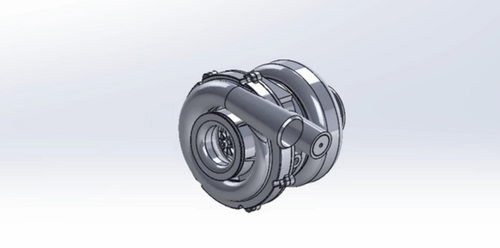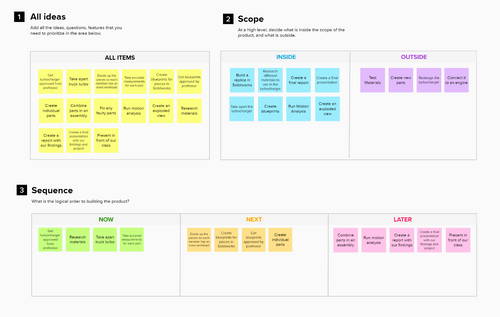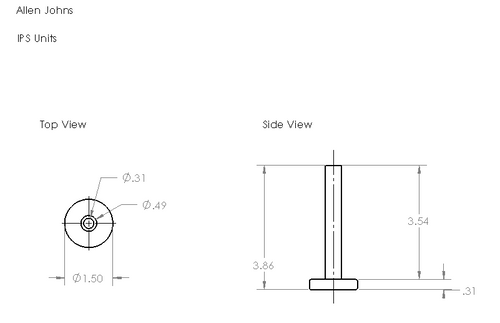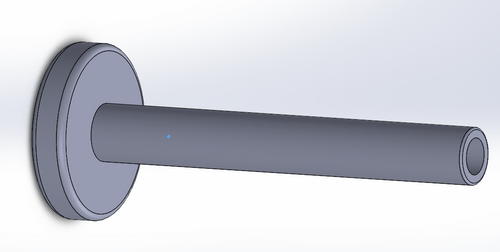Team Size: 3 | Project Duration: 3 weeks | Role: Product Designer
Possible Use Cases:
Completed prototype could be handed off to a R&D team at GM.
Tools Used:

My team designed an exact 3D replica of the 2006 GMC Duramax turbocharger. A turbocharger is a small turbine that sits between the engine and the exhaust in a vehicle. The turbocharger uses exhaust gases to force more air into your truck's engine. The increase in the air allows more fuel to be burned and can increase the engine's efficiency by 20-40%. The 2006 GMC Duramax turbocharger results in better throttle response, increased fuel economy, lower exhaust gas temperatures (EGTs), and better drivability for the 2006 Chevy GMC 6.6L Duramax LBZ engine it is designed for. Turbochargers are designed to last the same duration as an engine and are also covered by a warranty. A faulty turbocharger results in a poor experience for the owner and costly warranty claims for the automotive industry.


I worked within a small project team to create a 3D prototype of our faulty GM turbocharger. Our goal was to recreate the 2006 Chevy GMC Duramax engine's turbocharger in Solidworks. The engine on average lasts over 300,000 miles; however, the internal bearings on the turbocharger often give out prematurely. The team researched new materials that could potentially resist premature failure without requiring a complete overhaul of the design. Our team spent three weeks breaking apart the turbocharger and then recreating the parts in Solidworks. Once we produced all the parts, our team assembled the turbocharger and ran motion analysis. The completed prototype can now be used to test new materials.
My group took time at the beginning of the project to clearly define our scope so we could stay on target and hit our deadlines. We had to create a replica of our turbocharger in Solidworks with all its moving components. We also had to research potential materials that could be used to increase the lifespan of the turbocharger and then create a report and presentation. We deemed that actually testing the materials was not practical due to the timeframe and the exact material properties being proprietary. We also decided we would create a 1:1 replica and not include any new parts or redesign any parts in the turbocharger.
We also split our tasks into stages. First up we had to get the turbocharger idea approved by our professor. We also had to take apart the truck turbo and then take accurate measurements of each part. This was a part we could not rush since all the parts need to fit together perfectly at the end. While the turbo was being disassembled and cleaned, we had time to begin our research for materials to improve the longevity of the parts. Next up our team had to divvie the parts between the team members. Once the parts were assigned, team members would create blueprints for the parts and get them approved by the professor. Once the blueprints were approved, we created the individual parts. The final tasks were as follows. My team had to combine all the parts we created together into a working assembly. Once the assembly was created we had to create an exploded view of the parts and run motion analysis. We then had to combine our research and prototype to create a report with our findings. Finally, my team created a presentation and presented it in front of our class.

Prototyping for a physical product was a unique challenge. The first course of action was to dissemble the turbocharger and divide up the pieces. We then used digital calipers to take exact measurements for all our parts. For some of the radial parts, we had to measure the diameter and then use formulas to find the circumference and radius as needed.
Before we began designing the turbocharger, each team member created blueprints for a few parts. We used the dimensions we collected and then created the blueprints right in Solidworks. We showcased our blueprints to our Professor and got his approval to begin work on the turbochargers. One of the blueprints can be seen below.
Once the parts were divvied up, measurements were taken, and blueprints were made we designed the parts individually. This part of the process lasted roughly one week and involved us occasionally asking for assistance from teammates and our professor. Once our parts were created we assembled the parts in an assembly. For the turbocharger to be functional we had to mate all the parts together and test the motion.


This project produced many hurdles. Our team was initially four people. Unfortunately one of our team members dropped the class the week this was assigned. We started with a smaller team and had to divide the work of four into a three-man team. Luckily everyone on the team stepped up and picked up the difference.
The parts we designed were more complex than what we previously built in our labs. While designing the parts, we frequently had to learn and incorporate new features from Solidworks. Our group also ran into many issues when assembling the part. We had issues with pieces not being to scale and other pieces not fitting properly. This was due to errors when taking measurements. As a team, we immediately scaled the parts without requiring any redesigns. In this project, our inexperience in product design led to many such hurdles. My team had never designed in a 3D space before. However, we managed to make the necessary changes on time without compromising quality.
The final prototype works as intended. It is a 1:1 identical model of a 2006 GMC Duramax turbocharger. Using this model and inputting the material qualities of Silicon Nitride, we would be able to run stress tests and analyze the material. Unfortunately, the exact specifications of Silicon Nitride are not available to the public. This paired with the limited timeframe of this project prevented the team from being able to test Silicon Nitride in the bearings for this turbocharger.
The new purpose for our final prototype will be for it to be used by a research team. This finished prototype could be handed off to a research team that could run simulations. The research team could enter the exact specifications of new materials such as Silicon Nitride and then run tests to see if they can withstand the stress over a prolonged period. If the research team can find a suitable substitute material, GM could make future turbos last as long as the engines themselves. This would ideally save GM money with warranties and keep their customers happy with a long-lasting product. By only changing the materials used in the internal bearings, we would avoid the expensive process of a full product redesign.
This project was successful in meeting the needs and requirements of our class project. My teammates and I all received an A grade on this project. The product was also of sufficient quality to be handed over to a client such as GM or Chevy. From there, they would be able to benefit by using the prototype for their various needs.
I gained much insight while working on this project. The foremost being, the ability to collaboratively develop in 3D space. Throughout the course of the project, I have become adept in Solidworks. Another point of interest was I had to learn to work with a smaller margin for error. For parts as detailed and nuanced as a truck turbo, even the tiniest mistake means the components do not assemble properly. If my team and I had double and triple-checked all our measurements, we could have prevented issues during the assembly. However, this experience did make us learn how to quickly adapt our designs during assembly. Also despite being on a tight timetable and losing a team member, we did not let quality suffer. By focusing on the end goal, instead of obstacles, we managed to succeed.